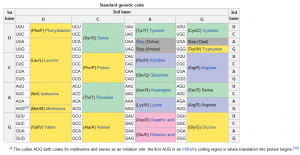Within each and every living organism, there are millions of books describing things from “how to move” to “how to eat”. These books are written in DNA: language of life. Ultimately, DNA is how nature writes about how to live, and the readers are how all living (and some “dead things”) survive. Even your own body is reading from your own library as you read this blog.
But within this massive collection, we, as people, cannot read most of it because we do not yet understand the language.
However, what we have figured out, thanks to genetics, cellular biology, and biochemistry, are the basic letters of these books; we have the codon table.

The codon table encoding the 20 essential amino acids used in all walks of life. Obtained as a screen capture from http://en.wikipedia.org/wiki/DNA_codon_table
What this codon table tells us is the 20 letters of the DNA alphabet, representing the 20 amino acids. When there are multiple letters together, they can spell a word, also known as a protein.
We have also figured out some parts of these books through areas called open reading frames. These areas use a process called transcription and translation, which is described in the following video found on youtube posted by redandbrownpaperbag.

We also have clues and insights into some other parts of these books, namely the promoter and termination sequences. These parts tell us where there is an open-reading frame, essentially acting as quotation marks to direct the cell’s attention to a specific location.
Despite all these advances in understanding the language, we know very little in reality.
First of all, there are no known “rules” to writing words, because a word can be as short as 2 letters to as long as a million letters.
Secondly, we do not have a clear picture of how different areas within the genome that are neither open reading frames nor promoters/terminaters interact with the cell, or why those books are there in the first place. These sequences are currently hypothesized as useless, but may be useful as the ENCODE project suggests.
Finally, some words, even with the same spelling, can have many different meanings when they are in different compartments of a cell, so figuring out what they actually mean is quite difficult.
The secret language of DNA might one day be uncovered; someone who can speak “DNA” might be able to take a piece of DNA and then tell us exactly what that DNA is used for, which can advance science from treating and preventing disease, finding new applications for cells (i.e. sustainable fuel), or even figure out what consciousness is. Knowing how to read DNA can open up a brave new world in understanding life as we know it.
Just like how the discovery of the Rosetta Stone lead us to understand the Egyptian language, we may be able to slowly construct our own Rosetta Stone, through genetics and biochemistry, to unravel the mystery of DNA.
The hope is that one day, understanding an organism will be as simple as reading a book.
– Tony Hui

